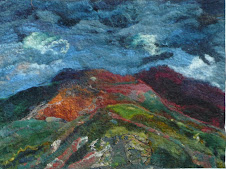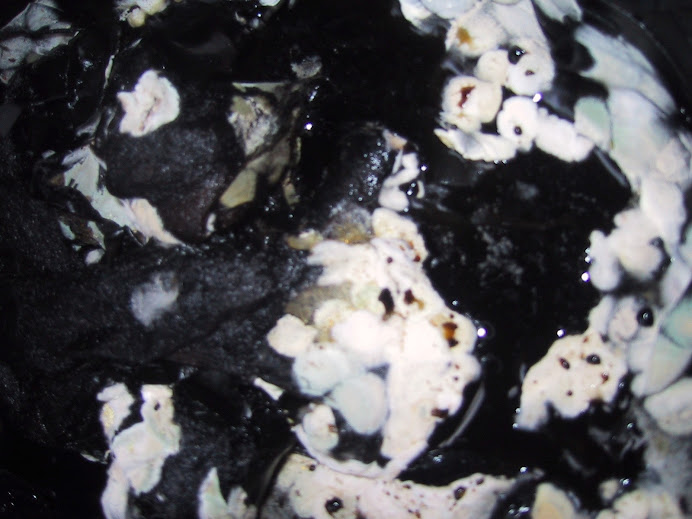
I wrote this blog as I actually did it. So I apologise it if sounds a bit too detailed. I thought I would try it as an experiment as I usually keep notes on my computer anyway.
10.45. I picked 100g of leaves of I. Indigotica and of woad I. Tinctoria . The leaves of chinese woad, I indigotica, on the left are thicker and slightly more bluey in colour than the leaves of I. Tinctoria
I poured one litre of nearly boiling water over the leaves and left to steep for about half an hour (coffee break time!)
I squeezed out the leaves and the I. Isatis on the left, gave a characteristic sherry coloured liquid but with a pink cast. although this has not come out on the photograph. The I. Indigotica, on the right was darker in colour with almost a purplish cast.

I added 1 tablespoon of washing soda ( sodium carbonate) to each which gave a PH of between 9 and 10 a little higher than I intended. Then I whisked them both for 2 minutes (and did my wrist ache!)
I. Tinctoria went a light green then on beating for 2 minutes a dark green with a slightly blue froth.
I. Indigotica went a bright green followed by very dark green and after 2 minutes of beating the froth had a dark blue cast to it.
The I. Isatis was in a wide bowl and the I indigotica was in a three litre jug so when I squeezed the leaves out this was still very hot ( at about 60 degrees C) while the I. Tinctoria was just tepid.
I added 1/8th teaspoon of Thiourea Dioxide commonly known as spectralite as a deoxygenator to each and left them for half an hour. I did wonder whether the I. Tinctoria might need more being in a wide bowl where the liquid might have absorbed more oxygen. but decided to see what happened.
In the mean time I weighed out 25 g of wet mordanted leicester long wool curls for each vat (mordanted as that is what I had wet and ready for dyeing)
I decided it was a bit difficult to compare the two vats when they were in such different size bowls which effected the temperature so I transferred both vats into one litre jugs and placed in a big bowl with boiling water in to have them both at the same temperature and added a little more Thiourea Dioxide to compensate for adding oxygen as I transferred them, and left them for 10 minutes or so. The I Tinctoria was at 48 degrees the I. Indigotica was at 42 degrees C.
I added the fibres at 12.40 and left for 20 minutes. as I was interrupted by a phone call!
I removed both and allowed to oxidise for about 20 minutes. As you can see the I Indigotica ( the one on the right ) is a darker blue.

I put half of the fibres back for 5 minutes and both went a bit darker.
The dogs got walked at this point so I returned to my two little vats at 5.00pm adding more hot water to the bowl to warm them up, 25ml of washing soda solution* as the pH had dropped to 8 , and 1/8tsp approx of thiourea dioxide.
* Washing soda solution is made by adding 4 tablespoons of washing soda ( sodium carbonate) to 1 litre of water.
I then added back half again of the previous clump of curls. (pH between 8-9 and temp at 38 degrees C) and left for five minutes removed and oxidised. I went on doing this until the fibres really did not look any darker. You can these results below with I.Tintoria (the ordinary Woad) on top and the I. Indigotica (Chinese Woad) on the bottom. There was still colour in both vats so dyed some more fibres a nice light blue photo not shown as the light was going !
Ps DH (a very supportive and encouraging man) says to all readers of my blog READ THE MACHINE STOPS BY EM FORSTER and prepare for the future .


 Finally at nearly 4 o clock we found all our fibres in the Persicaria Tinctoria had turned a beautiful turquoise and everyone was pleased and excited (especialy me as this was only the fourth time I had used the fresh leaves to get turquoise with one failure.) Below is a silk cap on the left, handspun tencel yarn ( spun by Maureen) and Teeswater curls on the right.
Finally at nearly 4 o clock we found all our fibres in the Persicaria Tinctoria had turned a beautiful turquoise and everyone was pleased and excited (especialy me as this was only the fourth time I had used the fresh leaves to get turquoise with one failure.) Below is a silk cap on the left, handspun tencel yarn ( spun by Maureen) and Teeswater curls on the right. The photo below shows the bucket after dyeing which today has gone a deep blue with grains of stuff on the bottom which I assume is indigotin settling out.
The photo below shows the bucket after dyeing which today has gone a deep blue with grains of stuff on the bottom which I assume is indigotin settling out. 














 So this year, I thought I would dye a lot especially with the genista and with the golden rod as neither of these seem to give such a good colour after drying. I don't think that weld does either but it is such a strong dye I don't think we realise how much is lost. Sometime ago Kevin from the Online Guild of Weavers Spinners and Dyers generously sent me his method for making an extract from weld so I think I might try this. Then I found myself thinking maybe I would freeze some golden rod as our freezer is seriously underused. I wonder whether anyone has tried this I know Bettina
So this year, I thought I would dye a lot especially with the genista and with the golden rod as neither of these seem to give such a good colour after drying. I don't think that weld does either but it is such a strong dye I don't think we realise how much is lost. Sometime ago Kevin from the Online Guild of Weavers Spinners and Dyers generously sent me his method for making an extract from weld so I think I might try this. Then I found myself thinking maybe I would freeze some golden rod as our freezer is seriously underused. I wonder whether anyone has tried this I know Bettina 



















